child restraint BMW CONVERTIBLE 1998 Owners Manual
[x] Cancel search | Manufacturer: BMW, Model Year: 1998, Model line: CONVERTIBLE, Model: BMW CONVERTIBLE 1998Pages: 179, PDF Size: 3.51 MB
Page 11 of 179
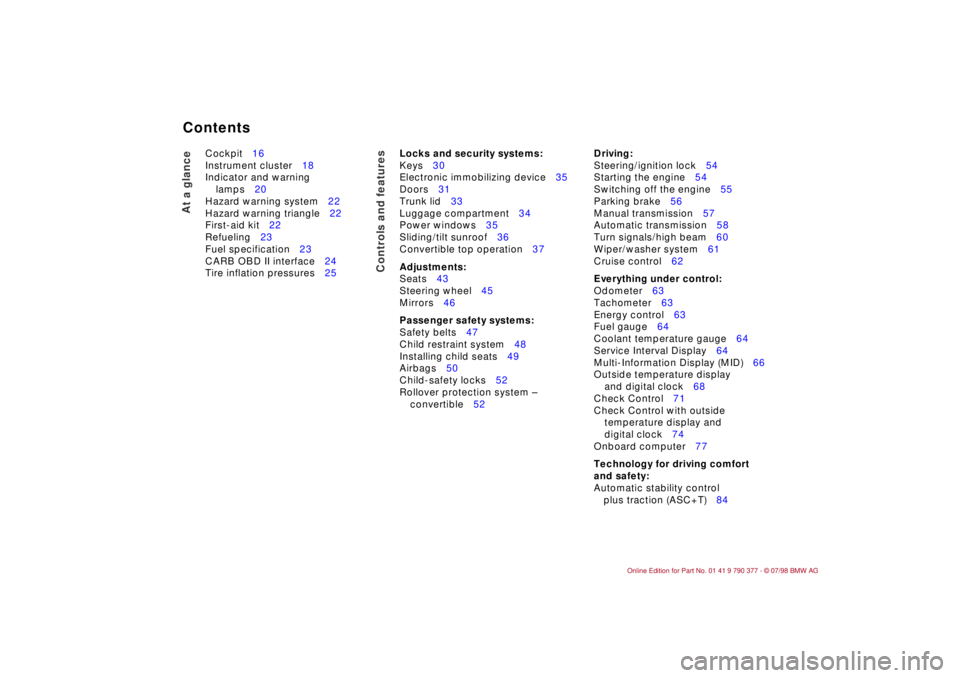
Contents
At a glance
Controls and features
Cockpit16
Instrument cluster18
Indicator and warning
lamps20
Hazard warning system22
Hazard warning triangle22
First-aid kit22
Refueling23
Fuel specification23
CARB OBD II interface24
Tire inflation pressures25
Locks and security systems:
Keys30
Electronic immobilizing device35
Doors31
Trunk lid33
Luggage compartment34
Power windows35
Sliding/tilt sunroof36
Convertible top operation37
Adjustments:
Seats43
Steering wheel45
Mirrors46
Passenger safety systems:
Safety belts47
Child restraint system48
Installing child seats49
Airbags50
Child-safety locks52
Rollover protection system Ð
convertible52
Driving:
Steering/ignition lock54
Starting the engine54
Switching off the engine55
Parking brake56
Manual transmission57
Automatic transmission58
Turn signals/high beam60
Wiper/washer system61
Cruise control62
Everything under control:
Odometer63
Tachometer63
Energy control63
Fuel gauge64
Coolant temperature gauge64
Service Interval Display64
Multi-Information Display (MID)66
Outside temperature display
and digital clock68
Check Control71
Check Control with outside
temperature display and
digital clock74
Onboard computer77
Technology for driving comfort
and safety:
Automatic stability control
plus traction (ASC+T)84
Page 29 of 179
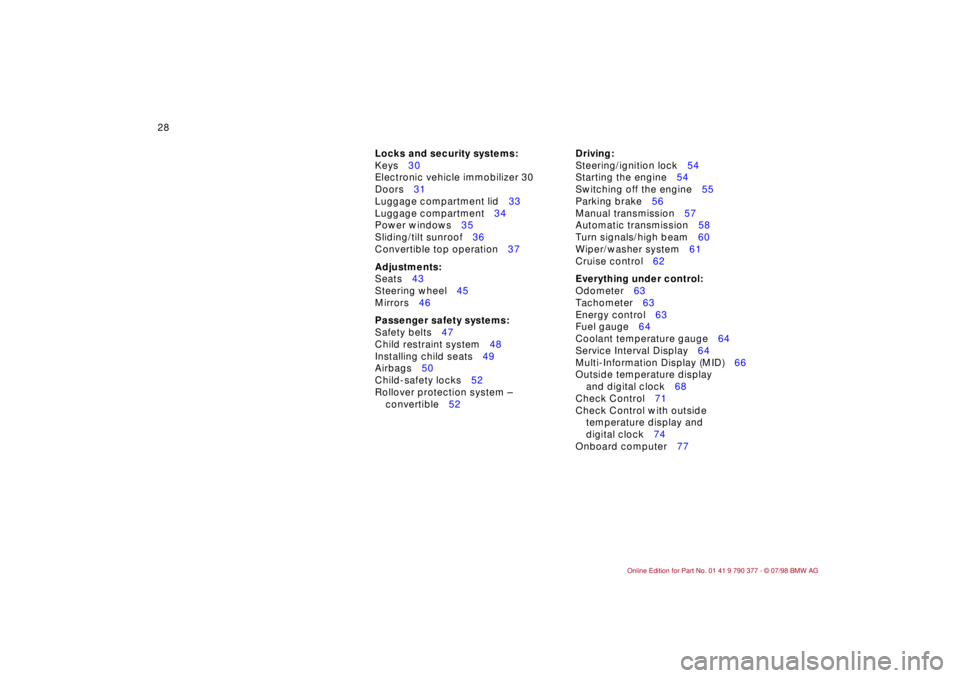
28
Locks and security systems:
Keys30
Electronic vehicle immobilizer 30
Doors31
Luggage compartment lid33
Luggage compartment34
Power windows35
Sliding/tilt sunroof36
Convertible top operation37
Adjustments:
Seats43
Steering wheel45
Mirrors46
Passenger safety systems:
Safety belts47
Child restraint system48
Installing child seats49
Airbags50
Child-safety locks52
Rollover protection system Ð
convertible52Driving:
Steering/ignition lock54
Starting the engine54
Switching off the engine55
Parking brake56
Manual transmission57
Automatic transmission58
Turn signals/high beam60
Wiper/washer system61
Cruise control62
Everything under control:
Odometer63
Tachometer63
Energy control63
Fuel gauge64
Coolant temperature gauge64
Service Interval Display64
Multi-Information Display (MID)66
Outside temperature display
and digital clock68
Check Control71
Check Control with outside
temperature display and
digital clock74
Onboard computer77
Page 48 of 179
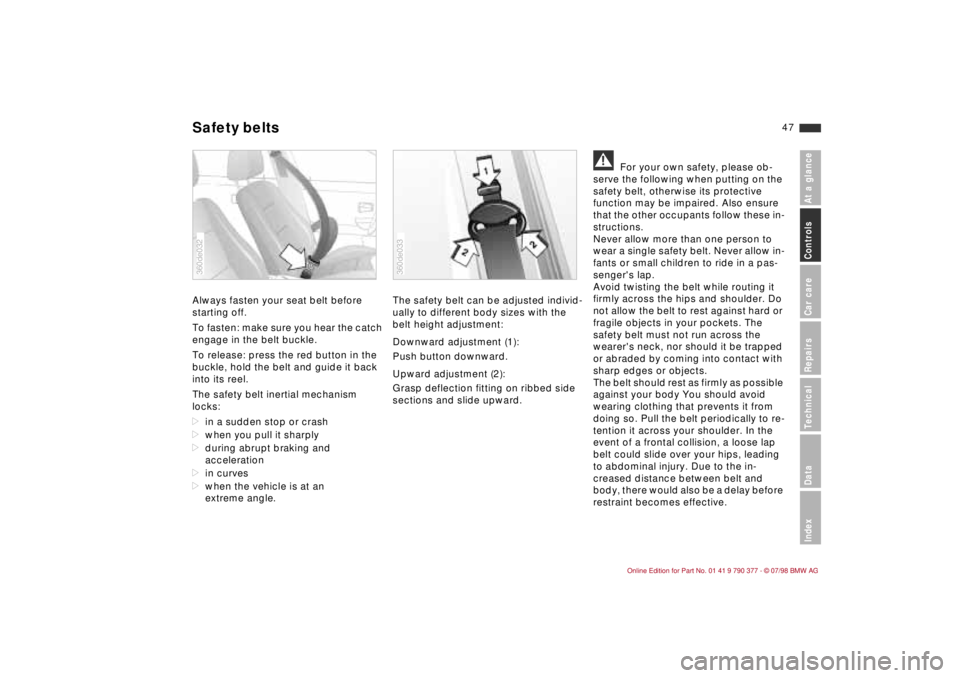
47
At a glanceControls Car careRepairsTechnicalDataIndex
Always fasten your seat belt before
starting off.
To fasten: make sure you hear the catch
engage in the belt buckle.
To release: press the red button in the
buckle, hold the belt and guide it back
into its reel.
The safety belt inertial mechanism
locks:
din a sudden stop or crash
dwhen you pull it sharply
dduring abrupt braking and
acceleration
din curves
dwhen the vehicle is at an
extreme angle.The safety belt can be adjusted individ-
ually to different body sizes with the
belt height adjustment:
Downward adjustment (1):
Push button downward.
Upward adjustment (2):
Grasp deflection fitting on ribbed side
sections and slide upward.
a
For your own safety, please ob-
serve the following when putting on the
safety belt, otherwise its protective
function may be impaired. Also ensure
that the other occupants follow these in-
structions.
Never allow more than one person to
wear a single safety belt. Never allow in-
fants or small children to ride in a pas-
senger's lap.
Avoid twisting the belt while routing it
firmly across the hips and shoulder. Do
not allow the belt to rest against hard or
fragile objects in your pockets. The
safety belt must not run across the
wearer's neck, nor should it be trapped
or abraded by coming into contact with
sharp edges or objects.
The belt should rest as firmly as possible
against your body You should avoid
wearing clothing that prevents it from
doing so. Pull the belt periodically to re-
tention it across your shoulder. In the
event of a frontal collision, a loose lap
belt could slide over your hips, leading
to abdominal injury. Due to the in-
creased distance between belt and
body, there would also be a delay before
restraint becomes effective.
360de032
360de033
Safety belts
Page 49 of 179

48
Expectant mothers should always wear
their safety belts, taking care to position
the lap belt against the lower hips,
where it will not exert pressure against
the abdominal area.
Never attempt to modify the safety
belts.c
For care instructions refer to page 134.Never install a rear-facing child restraint
system in the front passenger's seat!
Never attempt to modify either the
safety belts or any child restraint sys-
tem.
Should the safety belts be damaged or
stretched in an accident, the entire belt
system - including safety belt tension-
ers - must be replaced and the anchor-
ing mounts inspected at a BMW
Retailer.
If the safety belt tensioner has been
activated, a distance of roughly 0.8 in
(20 mm) will remain between the safety
belt lock and the tensioner module.
Installing child restraintsTo install and secure child restraint sys-
tems, all rear safety belts (and the front
passenger's safety belt) are equipped
with a special locking mode.
A label with operating instructions is
attached to the belt next to the latch
plate.To lock the beltExtract the entire length of the belt from
the inertia reel mechanism. Allow the
reel to retract the belt somewhat and
engage the buckle, then tighten the belt
against the child restraint system. The
retraction mechanism is now locked.
Always observe the installation instruc-
tions provided by the manufacturer of
the child restraint system.360us125
Safety belts Child restraint system
Page 50 of 179
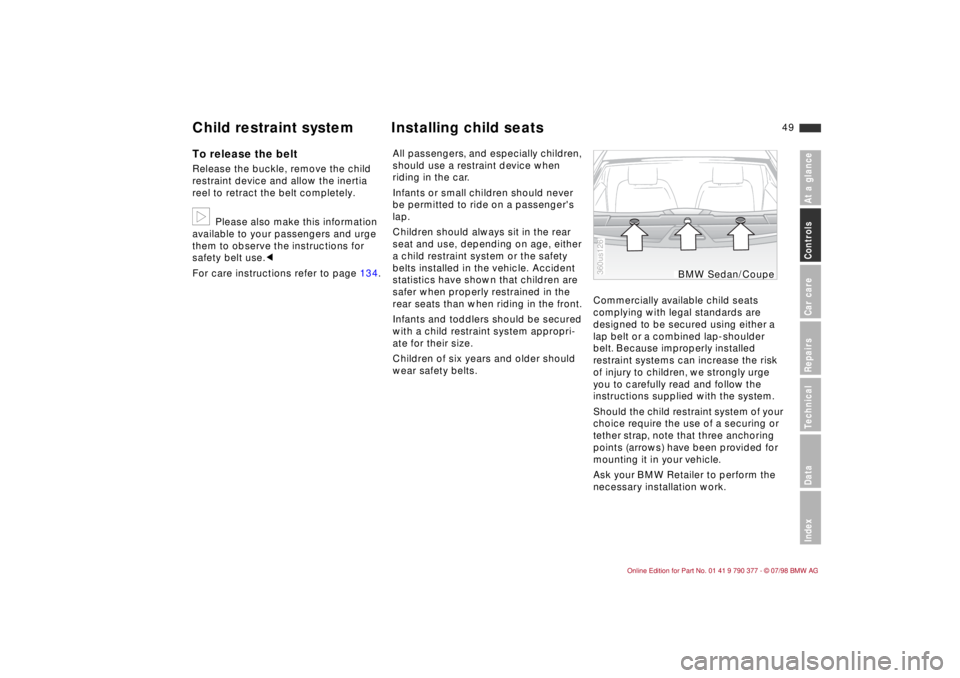
49
At a glanceControls Car careRepairsTechnicalDataIndex
To release the beltRelease the buckle, remove the child
restraint device and allow the inertia
reel to retract the belt completely.b
Please also make this information
available to your passengers and urge
them to observe the instructions for
safety belt use.c
For care instructions refer to page 134.All passengers, and especially children,
should use a restraint device when
riding in the car.
Infants or small children should never
be permitted to ride on a passenger's
lap.
Children should always sit in the rear
seat and use, depending on age, either
a child restraint system or the safety
belts installed in the vehicle. Accident
statistics have shown that children are
safer when properly restrained in the
rear seats than when riding in the front.
Infants and toddlers should be secured
with a child restraint system appropri-
ate for their size.
Children of six years and older should
wear safety belts.Commercially available child seats
complying with legal standards are
designed to be secured using either a
lap belt or a combined lap-shoulder
belt. Because improperly installed
restraint systems can increase the risk
of injury to children, we strongly urge
you to carefully read and follow the
instructions supplied with the system.
Should the child restraint system of your
choice require the use of a securing or
tether strap, note that three anchoring
points (arrows) have been provided for
mounting it in your vehicle.
Ask your BMW Retailer to perform the
necessary installation work.
360us126
BMW Sedan/Coupe
Child restraint system Installing child seats
Page 51 of 179
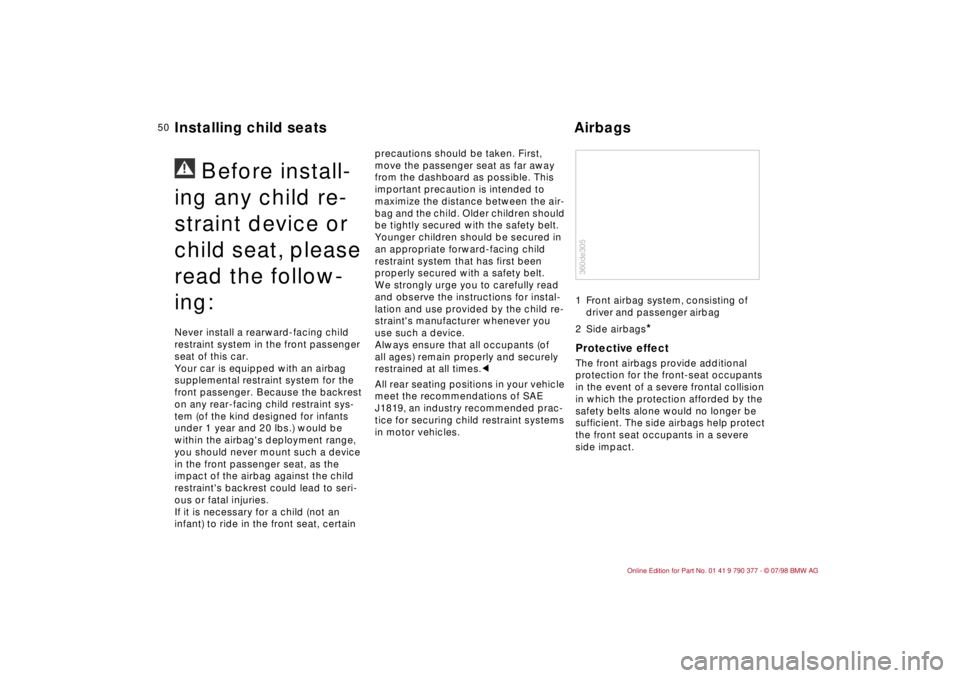
50
a
Before install-
ing any child re-
straint device or
child seat, please
read the follow-
ing:
Never install a rearward-facing child
restraint system in the front passenger
seat of this car.
Your car is equipped with an airbag
supplemental restraint system for the
front passenger. Because the backrest
on any rear-facing child restraint sys-
tem (of the kind designed for infants
under 1 year and 20 lbs.) would be
within the airbag's deployment range,
you should never mount such a device
in the front passenger seat, as the
impact of the airbag against the child
restraint's backrest could lead to seri-
ous or fatal injuries.
If it is necessary for a child (not an
infant) to ride in the front seat, certain precautions should be taken. First,
move the passenger seat as far away
from the dashboard as possible. This
important precaution is intended to
maximize the distance between the air-
bag and the child. Older children should
be tightly secured with the safety belt.
Younger children should be secured in
an appropriate forward-facing child
restraint system that has first been
properly secured with a safety belt.
We strongly urge you to carefully read
and observe the instructions for instal-
lation and use provided by the child re-
straint's manufacturer whenever you
use such a device.
Always ensure that all occupants (of
all ages) remain properly and securely
restrained at all times.c
All rear seating positions in your vehicle
meet the recommendations of SAE
J1819, an industry recommended prac-
tice for securing child restraint systems
in motor vehicles.1 Front airbag system, consisting of
driver and passenger airbag
2 Side airbags
*
Protective effectThe front airbags provide additional
protection for the front-seat occupants
in the event of a severe frontal collision
in which the protection afforded by the
safety belts alone would no longer be
sufficient. The side airbags help protect
the front seat occupants in a severe
side impact.360de305
Installing child seats Airbags
Page 52 of 179
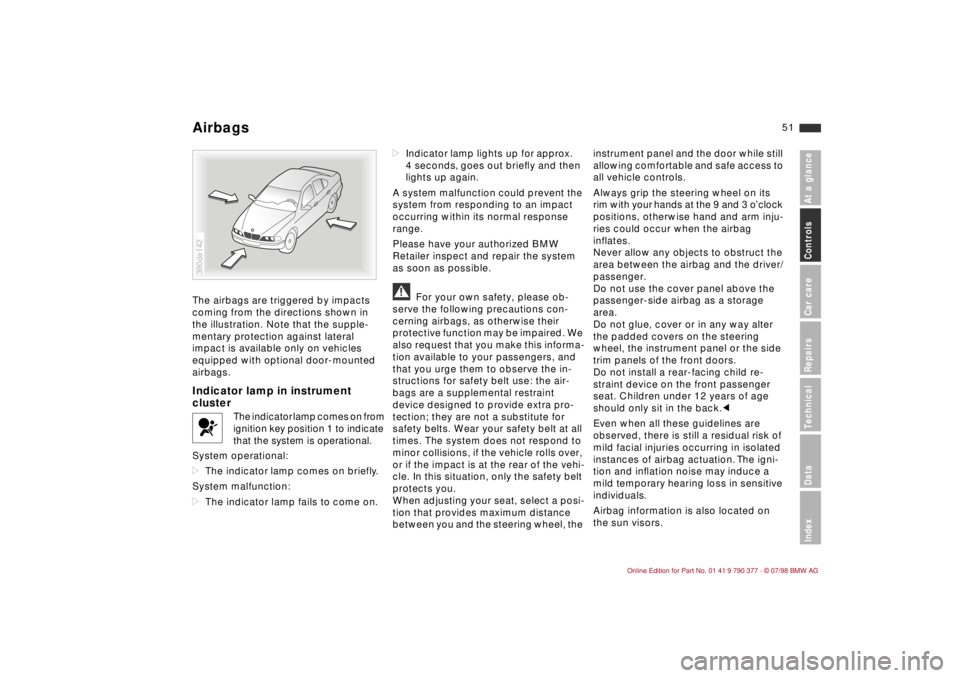
51
At a glanceControls Car careRepairsTechnicalDataIndex
The airbags are triggered by impacts
coming from the directions shown in
the illustration. Note that the supple-
mentary protection against lateral
impact is available only on vehicles
equipped with optional door-mounted
airbags.Indicator lamp in instrument
clusterSystem operational:
dThe indicator lamp comes on briefly.
System malfunction:
dThe indicator lamp fails to come on.dIndicator lamp lights up for approx.
4 seconds, goes out brießy and then
lights up again.
A system malfunction could prevent the
system from responding to an impact
occurring within its normal response
range.
Please have your authorized BMW
Retailer inspect and repair the system
as soon as possible.
a
For your own safety, please ob-
serve the following precautions con-
cerning airbags, as otherwise their
protective function may be impaired. We
also request that you make this informa-
tion available to your passengers, and
that you urge them to observe the in-
structions for safety belt use: the air-
bags are a supplemental restraint
device designed to provide extra pro-
tection; they are not a substitute for
safety belts. Wear your safety belt at all
times. The system does not respond to
minor collisions, if the vehicle rolls over,
or if the impact is at the rear of the vehi-
cle. In this situation, only the safety belt
protects you.
When adjusting your seat, select a posi-
tion that provides maximum distance
between you and the steering wheel, the instrument panel and the door while still
allowing comfortable and safe access to
all vehicle controls.
Always grip the steering wheel on its
rim with your hands at the 9 and 3 oÕclock
positions, otherwise hand and arm inju-
ries could occur when the airbag
inflates.
Never allow any objects to obstruct the
area between the airbag and the driver/
passenger.
Do not use the cover panel above the
passenger-side airbag as a storage
area.
Do not glue, cover or in any way alter
the padded covers on the steering
wheel, the instrument panel or the side
trim panels of the front doors.
Do not install a rear-facing child re-
straint device on the front passenger
seat. Children under 12 years of age
should only sit in the back.c
Even when all these guidelines are
observed, there is still a residual risk of
mild facial injuries occurring in isolated
instances of airbag actuation. The igni-
tion and inßation noise may induce a
mild temporary hearing loss in sensitive
individuals.
Airbag information is also located on
the sun visors.
p
The indicator lamp comes on from
ignition key position 1 to indicate
that the system is operational.
390de142Airbags
Page 53 of 179

52
Notes on safetyNever attempt to remove the gas gener-
ator for the airbag passenger-restraint
system from the vehicle. Testing and
service procedures are to be performed
exclusively by qualified technicians. In
the event of malfunction, deactivation
or triggering (in response to an acci-
dent), always entrust repair and service
operations to your authorized BMW
Retailer.
Do not modify or tamper with either the
wiring or the individual components in
the airbag system; these include also
the padded covers on the steering
wheel, on the instrument panel or on
the side trim panels of the front doors.
Never apply adhesive materials to these
components and never cover or modify
them in any way. Do not remove or dis-
mantle the steering wheel.
The airbag generator can be disposed
of only by a BMW Retailer.
Unprofessional attempts to service the
system could lead to failure in an emer-
gency or undesired airbag activation,
either of which could result in personal
injury.Insert the key in the slot in one of the
rear door latch mechanisms and turn
toward the outside: the door can now
be opened from the outside only.The rollover protection system is acti-
vated automatically in the event of an
accident or in a critical driving situation
(extreme tilting in the longitudinal or lat-
eral axis, loss of ground contact). The
protective bars located behind the rear
head restraints extend within a fraction
of a second.
In addition to the roll bar integrated in
the windshield frame, the rollover pro-
tection system helps provide all vehicle
occupants, and in particular the rear
passengers, with needed headroom.
b
When the hardtop
* is on, it is
advisable to use "soft" protective cov-
ers, in order to prevent damage to the
luggage compartment lid when the sys-
tem is activated. Please contact your
authorized BMW Retailer for additional
information.c
a
Always keep the space required by
the rollover protection system free of
obstacles.
In the case of minor, non-rollover acci-
dents, passengers are protected only by
the buckled safety belt and the belt ten-
sioner and, depending on the severity of
the accident, the airbag restraint sys-
tem.c
360de012
BMW Sedan
Airbags Child-safety locks Rollover protection system*
Page 171 of 179

170
Note: This index does not correspond to the original manual in all details
AABS (Antilock Brake
System)
103
Acceleration values
163
Activated charcoal filter
92
Adjusting steering wheel 45
Air conditioner
91
Air distribution 90
Air pressure
111
Air supply
92
Airbag
50
Aluminum wheel
115
Antifreeze
105
, 127
Antifreeze,
Radiator
105
, 127
Antifreeze,
radiator
127, 105
Anti-lock braking system
ABS
103
Aquaplaning
100
, 111
ASC+T Automatic stability
control plus
Traction
Traktion
10
, 84
Ashtray
94
AUC Automatic
recirculated-air control
91
Automatic car washes
131
Automatic recirculated-air
control AUC
91
Automatic stability control
plus traction
ASC+T
10
, 84Automatic transmission
58
Capacity
166
Filling capacity
166
Autoradio
108
Average fuel
consumption
79
Average speed 78
Axle load, permissible
163
BBackrest unlock
45
Backup lights
57
, 143
Battery
149
, 167
Removal and
installation 150
Symbols
149
Battery capacity
167
Battery change
Key
145
Battery charge current
20
Battery electrolyte
149
Battery, discharged 153
Belts
47
blower 92
BMW Convertible
Car wash
136
Care
136
Electrical
Convertible top
actuation
39
Emergency closure
41
Fully automatic
Convertible top
actuation
39Hardtop
109
Manual convertible top
Actuation 41
Manual convertible top
actuation 37
Rear window
Ventilation 91
, 105
Rollover protection
system
52
Ski bag 97
Storage compartment
95
Vehicle
decommissioning
137
BMW Convrtible
Electrical windows
Lifters
36
BMW Hi-Fi System
93
BMW Sport seat
44
Brake fluid
128
Brake lights,
Replace bulbs
143
Brake pads
20
Brake system hydraulic
circuits
21
Brake-in procedure
100
Brakes
104
Defects 128
Interference
105
Braking system 105
Breaking in vehicle
100
Bulb replacement 141
CCar battery
149
Car wash
131
CARB OBD II interface
24
Care of upholstery
134
Care of wool velour 134
Care, exterior
132
Care, interior 133
Care, vehicle exterior
132
Catalytic converter
102
Cellular phone
108
Center armrest 95
Central brake light
143
Central locking system
31
Central locking system
button
32
Central locking unit
31
Changes,
technical
6
Charge-current indicator
light
20
Charging the battery
150
Check air pressure
25
Check control
71
Check Control with outside
temperature gauge and
digital clock 74
Check engine oil level
124
CHECK key
71
Check oil level 124
Childproof door locks
52
Child-restraint system 48
Cigarette lighter
94
Everything from A to Z